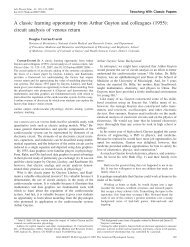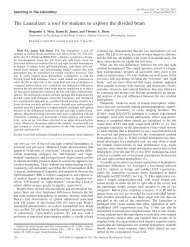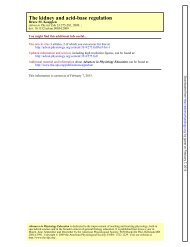construction of a model demonstrating neural pathways and reflex arcs
construction of a model demonstrating neural pathways and reflex arcs
construction of a model demonstrating neural pathways and reflex arcs
You also want an ePaper? Increase the reach of your titles
YUMPU automatically turns print PDFs into web optimized ePapers that Google loves.
I N N 0 V A T I 0 N S A N D I D E A S<br />
to the screws on the right side <strong>of</strong> the bulbs in the S-l interneuron wire between the screw on the left side<br />
<strong>and</strong> S-2 units. <strong>of</strong> the S-l unit <strong>and</strong> the left side <strong>of</strong> the S-3 unit.<br />
F. Tape these wires together so that they form a single<br />
unit with two terminals at one end (toward the battery<br />
unit) <strong>and</strong> four terminals attached to the synaptic units<br />
S-l <strong>and</strong> S-2 (Fig. 21).<br />
G. Loosen the two screws on the knife switch that are<br />
located farthest from the lamp on the S-l synaptic<br />
unit. Also loosen the two screws on the lamp <strong>of</strong> the<br />
S-3 unit. Attach one interneuron wire between the<br />
screw on the right side <strong>of</strong> the S-l unit <strong>and</strong> the screw<br />
on the right side <strong>of</strong> the S-3 unit. Attach the other<br />
H. To complete the <strong>reflex</strong> part <strong>of</strong> the pathway, loosen<br />
the screws on the knife switch farthest from the lamp<br />
on the S-3 unit. Connect the terminal ends <strong>of</strong> the<br />
motor neuron wires, one on each side, <strong>and</strong> tighten the<br />
screws to secure. Attach the alligator clips on the<br />
motor to the opposite ends <strong>of</strong> the wires.<br />
I. The second part <strong>of</strong> this pathway projects to the<br />
cerebral cortex. Therefore, there needs to be a circuit<br />
from the S-2 junction to the cerebral cortex. To do<br />
this, go back to the S-2 unit <strong>and</strong> loosen the two screws<br />
FIG. 21.<br />
This figure should be used in conjunction with directions for assembling the polysynaptic withdrawal<br />
<strong>reflex</strong> upon painful stimulus. Battery unit represents the stimulus/receptor. Wires labeled by color or tape<br />
follow the path <strong>of</strong> the sensory neurons to the spinal cord. Knife switch <strong>and</strong> lamp complexes correspond to<br />
the synaptic junctions located between the neurons. Wires labeled by color or tape follow the path <strong>of</strong> the<br />
motor neuron to the muscle effector. An additional set <strong>of</strong> wires labeled by color or tape follow the sensory<br />
neurons traveling to the cerebral cortex along the ascending tracts. Buzzer represents the cerebral cortex.<br />
In this <strong>model</strong> the muscle effector is represented by a motor.<br />
VOLUME 16 : NUMBER 1 - ADVANCES IN PHYSIOLOGY EDUCATION - DECEMBER 199G<br />
s39









